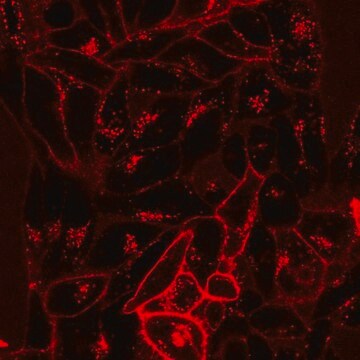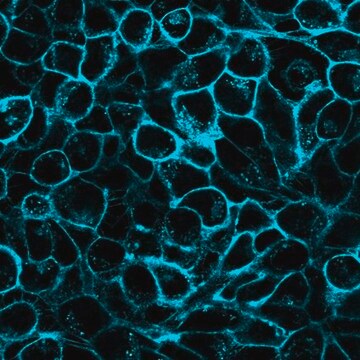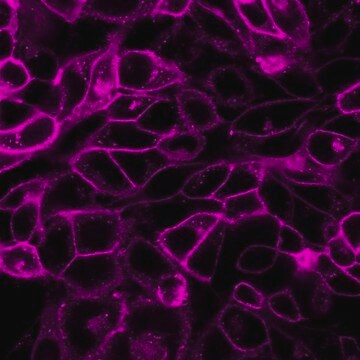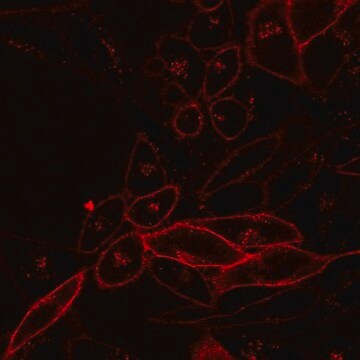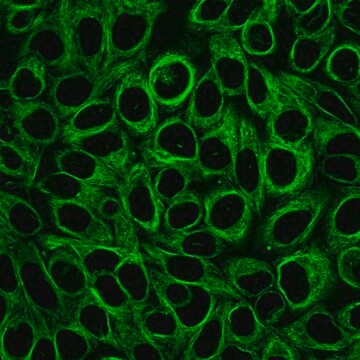SCT114
BioTracker NIR770 Cytoplasmic Membrane Dye
Live cell imaging lipophilic carbocyanine membrane dye suitable for long-term fluorescent cell labeling and cell tracking studies.
Sinónimos:
Live cell imaging probe
Iniciar sesiónpara Ver la Fijación de precios por contrato y de la organización
About This Item
Código UNSPSC:
12352207
NACRES:
NA.47
Productos recomendados
técnicas
cell based assay: suitable
método de detección
fluorometric
Condiciones de envío
ambient
Descripción general
Lipophilic carbocyanine dyes are widely used for labeling neurons in tissues by retrograde labeling, and to label membranes in a wide variety of cell types. The dyes are weakly fluorescent in aqueous phase, but become highly fluorescent in lipid bilayers. Staining is highly stable with low toxicity and very little dye transfer in between cells, making the dyes suitable for long-term cell labeling and tracking studies. When live cells are stained, the dyes label plasma membranes and also are taken up into endocytic compartments. Cells can be fixed either before or after staining, although permeabilization affects the staining pattern.
Unlike PKH dyes, BioTracker Cytoplasmic Membrane Dyes do not require a complicated hypoosmotic labeling protocol. They are ready-to-use dye delivery solutions that can be added directly to normal culture media to label suspended or adherent cells in culture.
NIR Cytoplasmic Membrane Dyes are novel near-infrared carbocyanine dyes for labeling the cytoplasmic membranes of living cells. Due to their long emission wavelengths, near-infrared cell membrane stains can be used to label cells for near-infrared small animal imaging studies for non-invasive imaging of cell migration and cell homing.
Spectral Properties
Absorbance: 767nm
Emission: 806nm
Unlike PKH dyes, BioTracker Cytoplasmic Membrane Dyes do not require a complicated hypoosmotic labeling protocol. They are ready-to-use dye delivery solutions that can be added directly to normal culture media to label suspended or adherent cells in culture.
NIR Cytoplasmic Membrane Dyes are novel near-infrared carbocyanine dyes for labeling the cytoplasmic membranes of living cells. Due to their long emission wavelengths, near-infrared cell membrane stains can be used to label cells for near-infrared small animal imaging studies for non-invasive imaging of cell migration and cell homing.
Spectral Properties
Absorbance: 767nm
Emission: 806nm
Aplicación
Live cell fluorescent imaging
Live cell imaging lipophilic carbocyanine membrane dye suitable for long-term fluorescent cell labeling and cell tracking studies.
Research Category
Cell Imaging
Cell Imaging
Research Sub Category
Live Cell Dye
Live Cell Dye
Calidad
Spectral Properties
Absorbance: 767nm
Emission: 806nm
Absorbance: 767nm
Emission: 806nm
Forma física
Liquid
Almacenamiento y estabilidad
Store BioTracker NIR770 Cytoplasmic Membrane Dye at room temp. Protect From Light.
Note: Centrifuge vial briefly to collect contents at bottom of vial before opening.
Note: Centrifuge vial briefly to collect contents at bottom of vial before opening.
Cláusula de descargo de responsabilidad
Unless otherwise stated in our catalog or other company documentation accompanying the product(s), our products are intended for research use only and are not to be used for any other purpose, which includes but is not limited to, unauthorized commercial uses, in vitro diagnostic uses, ex vivo or in vivo therapeutic uses or any type of consumption or application to humans or animals.
Código de clase de almacenamiento
10 - Combustible liquids
Clase de riesgo para el agua (WGK)
WGK 1
Punto de inflamabilidad (°F)
188.6 °F - (refers to pure substance)
Punto de inflamabilidad (°C)
87 °C - (refers to pure substance)
Certificados de análisis (COA)
Busque Certificados de análisis (COA) introduciendo el número de lote del producto. Los números de lote se encuentran en la etiqueta del producto después de las palabras «Lot» o «Batch»
¿Ya tiene este producto?
Encuentre la documentación para los productos que ha comprado recientemente en la Biblioteca de documentos.
Nuestro equipo de científicos tiene experiencia en todas las áreas de investigación: Ciencias de la vida, Ciencia de los materiales, Síntesis química, Cromatografía, Analítica y muchas otras.
Póngase en contacto con el Servicio técnico